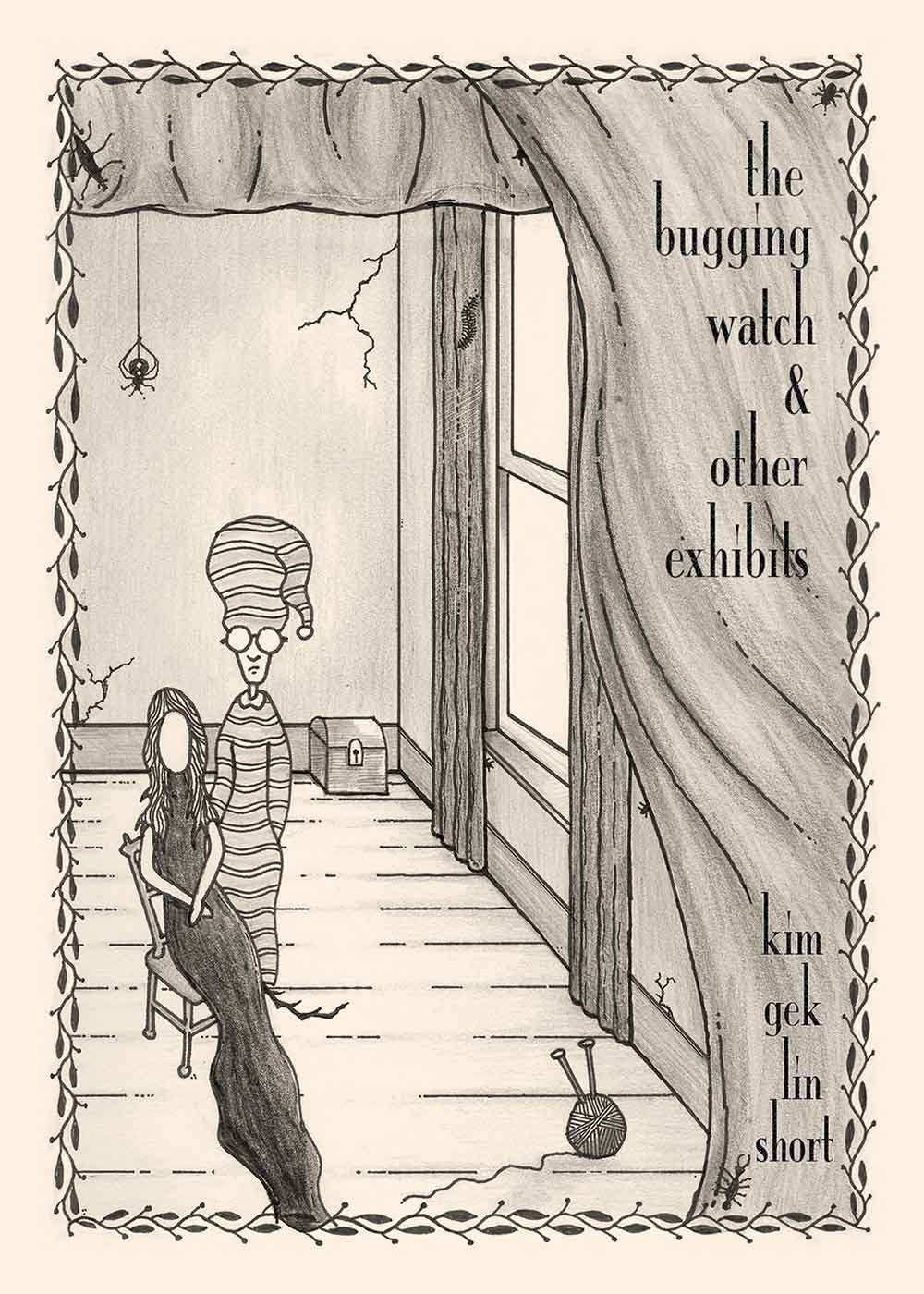
The Bugging Watch & Other Exhibits
by Kim Gek Lin Short
Lyric Novel. 72 pages, Paperback. 2010
Cover art by Daniel Rhodes
The Bugging Watch & Other Exhibits is the prose elegy of a boy who wants to be a bug in order to save by symbiosis the dead girl he loves. Can Harlan, in “the basement forever inside him,” conjure Toland back from “the scars of Monday”? Enacted in prose poems and cross-referenced datebooks, the inseparable lovers, Harlan and Toland, eternally rehearse for a real life together, repeating in that instant between being and nonbeing, the loss into which their love escaped.

The Bugging Watch & Other Exhibits
by Kim Gek Lin Short
Lyric Novel. 72 pages, Paperback. 2010
Cover art by Daniel Rhodes
The Bugging Watch & Other Exhibits is the prose elegy of a boy who wants to be a bug in order to save by symbiosis the dead girl he loves. Can Harlan, in “the basement forever inside him,” conjure Toland back from “the scars of Monday”? Enacted in prose poems and cross-referenced datebooks, the inseparable lovers, Harlan and Toland, eternally rehearse for a real life together, repeating in that instant between being and nonbeing, the loss into which their love escaped.
A strange romance of “the secret motions of things” (Francis Bacon, The New Atlantis, 1627), Kim Gek Lin Short’s The Bugging Watch and Other Exhibits is an exciting, mysterious, sometimes macabre new narrative. Her zany futuristic gothic opera of prose poems is threaded with magic, potions, passion, a “concert of hair,” a “hazmat of holes.” With its incantations of quantum teleology, its footnotes & sources, it is a magnificent work. Irresistible! (Norma Cole) A luminous and perverse fairy-tale to be read at the beginning of the day, preferably in that “chilly blue hour before 4 a.m.” Complete with footnotes, diagrams and an “unspeakable private crevice,” these prose “exhibits” display a prebiotic potential. What was “not quite alive,” becomes, in this swift, dark telling, “hot anyway,” “enchantment created inside everything,” and sometimes: “a poem about bugs.” Angels, lab technicians from the suburbs of Denver, men in ratty satin capes and artisans of all kinds populate this stunning and strange narrative, which is not a narrative: it is a “growing hole.” Enacting the desire and curiosity the book prompts, a reader might peer in, fall for a long time, then “miraculously return.” I repeat: do not read this book at night. If you do, I can’t—the book can’t—account for your new dreams. (Bhanu Kapil) This small unsettling book first proposes a stiflingly sweet symbiosis between two shut-in innamorati, and then lets its queer world subdivide in a theater of exfoliating roles. Most shocking in this miniature is the Rosebud at its center, a muse who breaks with her mate only to reinvent him out of bugs, ink and sugarwater. Like a Victorian photo collage mounting, say, the head of Prince Albert on a croquet mallet or umbrella handle, The Bugging Watch both conceals and reveals its morbidity, its twisted thirsts. (Joyelle McSweeney) I kept thinking: Catacomb Valentine. Sometimes we forget that ancient catacombs were mapped, negotiated—which is to say: read—by the placement of the graves of paupers. The tunnel diggers constellated this grammar so they would know how to navigate and create within lush darkness. The Bugging Watch & Other Exhibits, in its way, deeply reminds. The network of tunnels—between lives, between being (blink) and not being (blink)—and all papered with valentines, the sort cut from thick, mealy-colored childhood stock. Here is language as enchantment. (Selah Saterstrom) Short’s prose poems have the exactitude of obsessive compulsion, yet the imagery and dimness of an opiate trip sponsored by Lewis Caroll. . . . She frequently stretches the parameters of grammar, rearranging conventional syntax to just off kilter; her written style as surreal as her yarn-and-insect imagery. The result is a terrifying, ungraspable split-level love story: futile, sad and beautiful. (Jeremy Benson, NewPages) A beguiling and entirely enthralling collection of related prose poems . . . so unusual and provocative in its subtle oddities that I wonder how aware she is of what she’s done. . . . It is what you think when you read a story by George Saunders, or see a film by David Lynch, or flip through a comic by R. Crumb: how did this person know he could do this? (Ben Gottlieb, Art + Culture)
A strange romance of “the secret motions of things” (Francis Bacon, The New Atlantis, 1627), Kim Gek Lin Short’s The Bugging Watch and Other Exhibits is an exciting, mysterious, sometimes macabre new narrative. Her zany futuristic gothic opera of prose poems is threaded with magic, potions, passion, a “concert of hair,” a “hazmat of holes.” With its incantations of quantum teleology, its footnotes & sources, it is a magnificent work. Irresistible! (Norma Cole) A luminous and perverse fairy-tale to be read at the beginning of the day, preferably in that “chilly blue hour before 4 a.m.” Complete with footnotes, diagrams and an “unspeakable private crevice,” these prose “exhibits” display a prebiotic potential. What was “not quite alive,” becomes, in this swift, dark telling, “hot anyway,” “enchantment created inside everything,” and sometimes: “a poem about bugs.” Angels, lab technicians from the suburbs of Denver, men in ratty satin capes and artisans of all kinds populate this stunning and strange narrative, which is not a narrative: it is a “growing hole.” Enacting the desire and curiosity the book prompts, a reader might peer in, fall for a long time, then “miraculously return.” I repeat: do not read this book at night. If you do, I can’t—the book can’t—account for your new dreams. (Bhanu Kapil) This small unsettling book first proposes a stiflingly sweet symbiosis between two shut-in innamorati, and then lets its queer world subdivide in a theater of exfoliating roles. Most shocking in this miniature is the Rosebud at its center, a muse who breaks with her mate only to reinvent him out of bugs, ink and sugarwater. Like a Victorian photo collage mounting, say, the head of Prince Albert on a croquet mallet or umbrella handle, The Bugging Watch both conceals and reveals its morbidity, its twisted thirsts. (Joyelle McSweeney) I kept thinking: Catacomb Valentine. Sometimes we forget that ancient catacombs were mapped, negotiated—which is to say: read—by the placement of the graves of paupers. The tunnel diggers constellated this grammar so they would know how to navigate and create within lush darkness. The Bugging Watch & Other Exhibits, in its way, deeply reminds. The network of tunnels—between lives, between being (blink) and not being (blink)—and all papered with valentines, the sort cut from thick, mealy-colored childhood stock. Here is language as enchantment. (Selah Saterstrom) Short’s prose poems have the exactitude of obsessive compulsion, yet the imagery and dimness of an opiate trip sponsored by Lewis Caroll. . . . She frequently stretches the parameters of grammar, rearranging conventional syntax to just off kilter; her written style as surreal as her yarn-and-insect imagery. The result is a terrifying, ungraspable split-level love story: futile, sad and beautiful. (Jeremy Benson, NewPages) A beguiling and entirely enthralling collection of related prose poems . . . so unusual and provocative in its subtle oddities that I wonder how aware she is of what she’s done. . . . It is what you think when you read a story by George Saunders, or see a film by David Lynch, or flip through a comic by R. Crumb: how did this person know he could do this? (Ben Gottlieb, Art + Culture)
About the Author


About the Author